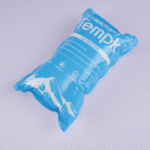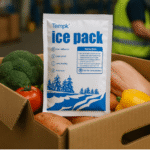Les packs de gel de glace peuvent-ils rester froids 48 HR comme la glace sèche?
Oui-Les packs de gel de glace restent froids 48 HR comme la glace sèche lorsque vous correspondez au point de consigne PCM, isolation, et emballer dans votre voie et valider avec un test thermique de 48 heures de style ISTA. Concevoir des routes congelées vers ≤0 ° F (−18 ° C), Choisissez −20 / −23 ° C PCM pour «Frozen-Class,»Et utilisez des EP / Pur ou VIP plus épais pour étirer le temps de maintien. Puis prouvez-le avec un enregistreur de données avant de mettre à l'échelle.
-
Quand les packs de gel de glace restent froids 48 HR comme la glace sèche? (conditions, limites, profils)
-
Quel PCM et l'isolation ont vraiment frappé 48 heures? (−23 ° C PCM, EPS vs Pur vs VIP)
-
De combien de packs de gel avez-vous besoin 48 heures? (calculatrice rapide et exemples)
-
Emballages en gel vs glace sèche - que devriez-vous choisir? (sécurité, règles, coût, cas d'utilisation)
-
2025 les tendances qui font 48 des heures plus faciles (VIP traditionnel, kits préqualifiés, PCMS plus verts)
Quand faire Les packs de gel de glace restent froids 48 HR comme la glace sèche?
Réponse courte: Les packs de gel de glace restent froids 48 HR comme la glace sèche sous un profil ambiant défini (Par exemple, ISTA7D) lorsque vous utilisez le point de consigne PCM correct (Par exemple, −23°C pour les surgelés), isolation adéquate, et un top lourd, emballage à faible vide. Validez avec un test de 48 heures et un enregistreur.
Pourquoi ça marche: Les packs de gel libèrent du « froid » à leur température de changement de phase. Gels à base d'eau (~ 0 ° C) convient aux voies réfrigérées; les PCM conçus à −20/−23°C desservent les voies gelées. Si le point de consigne est trop chaud ou si l'isolation est trop fine, votre réserve disparaît prématurément.. Utilisez 2,0″ EPS/PUR pendant 36 à 48 h, ou hybrides VIP pour 48-120h. Pour les aliments surgelés ou les glaces, viser ≤0°F (−18 ° C) tout au long de.
Quel PCM + livraison d'isolation 48 heures?
Détails: Pour les charges utiles de classe gelée, Associez un PCM à −23°C avec du EPS ou du PUR de 2,0″ pendant ~48h sous des profils modérés; passer aux panels VIP pour prolonger au-delà de 48 h ou réduire la taille de la boîte. Pour réfrigéré (2–8 ° C), +5 Les flacons/gels PCM °C et VIP atteignent régulièrement 48 à 120 heures.. Demandez toujours le rapport thermique (carte de la sonde, charge utile, courbe ambiante).
| Choix de conditionnement | Mur typique | Voie cible | Vos plats à emporter |
|---|---|---|---|
| −23 ° C PCM + PSE | 1.75–2,0 ″ | Surgelé ≤−18°C | Pratique 36 à 48 heures la plupart des saisons |
| −23 ° C PCM + Pur | 2.0" | Surgelé ≤−18°C | Plus de marge pour les itinéraires chauds |
| +5 ° C PCM + VIP | Mince | 2–8 ° C | 48–120h avec la plus petite empreinte au sol |
Conseils pratiques que vous pouvez appliquer aujourd'hui
-
PCM préconditionné pleinement (Par exemple, ≤−23°C pour les packs −23°C) pour 24 à 48h.
-
Pré-Chill à l'expéditeur donc le froid n'est pas une mousse de refroidissement « usée ».
-
Chargement par le haut de la plupart des PCM: puits de froid; placez des blocs plus épais au-dessus.
-
Éliminer les vides avec du kraft/mousse pour ralentir la convection.
Exemple de terrain: Une marque de desserts a remplacé 18 lb de glace carbonique par du PCM de −23 °C dans un expéditeur EPS de 2,0″ et a passé un profil d'été de 48 heures avec une variation de ≤2,8 °C sur l'ensemble du marché. 6 sondes, tout en évitant les problèmes de glace carbonique des compagnies aériennes.
Combien de packs de gel pour 48 heures donc Les packs de gel de glace restent froids 48 HR comme la glace sèche?
Répondre: Démarrez les voies gelées avec la masse PCM ≈ 0.8–1,2× masse de la charge utile en EPS et ajuster en fonction de l'ambiance et de l'accès. Utilisez VIP pour réduire la masse du PCM ou prolonger le temps. Qualifiez-vous toujours sur votre itinéraire avec un enregistreur.
Calculatrice de copie (Feuilles/Excel):
-
Base_lb_per_day (congelé): 10 pour PSE, 8 pour PUR, 6 pour VIP
-
Facteur_ambiant: 1.0 cool / 1.2 chaud / 1.4 chaud
-
Facteur_isolation: 1.0 VIP / 1.1 Pur / 1.3 PSE fin
-
Facteur_d'accès: 1.0 non-ouverture / 1.2 lumière / 1.4 fréquent
Exemple travaillé: 48 H, route chaude, PSE, accès à la lumière →=ROUNDUP((48/24)*10*1.2*1.3*1.2,0) = 38 lb de −23°C PCM (base/côtés/plateau distribués).
Disposition du pack qui fonctionne réellement
Étape par étape: Feuille PCM de base → charge utile serrée → PCM latéral/remplissage du vide → PCM supérieur épais; biaiser davantage de PCM vers le côté d'exposition "chaud" (Par exemple, premier/dernier kilomètre). Falls froids; les builds les plus lourds construisent l'endurance.
| Plan de superposition | Quoi utiliser | Épaisseur typique | Ce que ça fait pour vous |
|---|---|---|---|
| Base à tartiner | Feuille mince de PCM | 0.5–1″ | Uniformise la température au sol |
| Remplissage latéral | Petit remplissage PCM/vide | 0.5–1″ | Protège les murs chauds |
| Capuchon supérieur | Blocs PCM épais | 1–2″ | Prolonge le temps de maintien le plus long |
Conseils pratiques & conseil
-
Voies d'été: Ajoutez 15 à 25 % de PCM ou passez à PUR/VIP.
-
Les ouvertures coûtent du temps: Une seule ouverture peut brûler 1 à 3 heures de marge – conception pour un accès minimal.
-
Documenter les SOP: Photos + poids = répétabilité et moins de réclamations.
Packs de gel vs glace sèche – peut Les packs de gel de glace restent froids 48 HR comme la glace sèche pour tout?
Ça dépend. Les packs de gel de glace restent froids 48 HR comme la glace sèche pour les produits surgelés lorsque vous utilisez du PCM à −23 °C et une isolation solide; la glace carbonique gagne toujours pour les produits surgelés (≤−60°C) ou de très longues voies. La neige carbonique se situe à −78,5°C et est réglementée pour le transport aérien; de nombreux PCM ne sont pas des marchandises dangereuses (vérifier la FDS).
Règles, sécurité, et ce qu'ils signifient pour toi
-
Limites aériennes: La plupart des compagnies aériennes plafonnent la glace carbonique à proximité 2.5 kg (5.5 kg) par passager / colis; ventilation et marques requises. Les PCM contournent généralement l’étiquetage des matières dangereuses.
-
Besoins en produits: Utiliser +5 ° C PCM pour les médicaments à 2–8°C; −23 ° C PCM pour les aliments surgelés; utiliser glace carbonique pour ≤−60°C ou 72–120h de couloirs.
-
Preuve, pas des anecdotes: "48h" devrait correspondre à ISTA7D (ou similaire) avec cartes de sonde et masse de charge utile.
| Aspect | Packs de gel / PCM | Glace sèche | Ce que cela signifie pour vous |
|---|---|---|---|
| Température | +5 Consignes °C ou −20/−23°C | −78,5 ° C | Faire correspondre la consigne au produit; glace carbonique pour ultra-froid |
| Durée | 24–48h SPE; 48–120h VIP | 48 h+ avec masse | L'un ou l'autre peut faire 48h; VIP étend les performances du gel |
| Sécurité/Réglementation | Généralement non-DG | Étiquettes/limites relatives aux matières dangereuses | Les PCM simplifient la gestion aérienne et du dernier kilomètre |
| Coût/Réutilisation | Réutilisable, prévisible | Consommable, frais | Le PCM réduit le coût total de nombreuses voies de 2 jours |
2025 évolutions et tendances qui aident Les packs de gel de glace restent froids 48 HR comme la glace sèche
Aperçu de la tendance (2025): L’isolation VIP se généralise, offrant une valeur R par pouce plus élevée et permettant des prises de 48 à 120 heures avec moins de PCM. Kits préqualifiés 24/36/48 heures (réfrigéré et congelé) sont largement disponibles, faciliter les audits et accélérer le déploiement. Des PCM plus écologiques et des directives plus claires pour les compagnies aériennes réduisent la friction liée aux matières dangereuses.
Dernier progrès en un coup d'œil
-
Trousses VIP: Des boîtes plus petites, des délais plus longs (48–120h) pour 2–8°C et voies gelées.
-
PCM de classe gelée: Les gels à −23 °C sont désormais une alternative standard à la neige carbonique pour les itinéraires de 48 heures.
-
Une validation plus intelligente: Les vendeurs publient des durées arrondies; des rapports détaillés confirment les véritables performances.
Perspicacité du marché: Les expéditions alimentaires et pharmaceutiques de la DTC adoptent des systèmes VIP/PCM préqualifiés pour réduire les réclamations., fret rétractable, et évitez les formalités administratives relatives aux matières dangereuses, sans sacrifier la fiabilité 48 heures.
Questions fréquemment posées
Q1: Peut Les packs de gel de glace restent froids 48 HR comme la glace sèche en été?
Oui : utilisez un PCM à −23 °C, isolation plus épaisse (PUR ou VIP), et ajoutez un tampon PCM de 15 à 25 %; valider par rapport à un profil d'été avec un enregistreur.
Q2: Combien de packs de gel pour une boîte congelée moyenne (48 H)?
Attendre ~24 à 32 lb de −23°C PCM en EPS 2.0″ pour une charge utile moyenne; confirmer avec les tests d'itinéraire et le calculateur ci-dessus.
Q3: Les packs de gel sont-ils dangereux comme la neige carbonique?
Généralement non. De nombreux PCM ne sont pas réglementés comme marchandises dangereuses; la glace carbonique est réglementée et nécessite une ventilation et un étiquetage. Vérifiez votre FDS.
Q4: Ai-je toujours besoin d'un enregistreur de données si je me qualifie une fois?
Oui. Vérification sur votre itinéraire actuel (ITA-STYLE) détecte les variations ambiantes et gère les différences manquées par les tests en laboratoire.
Q5: Les packs de gel à 0 °C maintiendront-ils la crème glacée solide comme le roc?
Non. Utiliser −20/−23°C PCM (ou glace carbonique pour les voies ultra froides/longues) et une isolation plus épaisse pour arriver « durement congelé ».
Résumé & recommandations
Fin de compte: Les packs de gel de glace restent froids 48 HR comme la glace sèche quand tu corresponds −23 ° C PCM, EPS → PUR → VIP isolation, et un haut lourd, faible vide packout - et vous valider sous un profil thermique de 48 heures. La neige carbonique reste la meilleure solution pour des températures ≤−60°C ou de très longs trajets, mais PCM/VIP réduit la complexité des matières dangereuses et abaisse souvent le coût total.
Étapes suivantes (CTA):
-
Définissez votre cible (congelé ≤−18°C ou réfrigéré 2–8°C).
-
Sélectionnez le point de consigne PCM et le niveau d'isolation (visez VIP pour les voies les plus difficiles).
-
Utilisez la calculatrice pour dimensionner PCM; construire le sandwich « base/côtés/dessus ».
-
Exécutez un test de 48 heures avec un enregistreur; stocker le rapport thermique.
-
Déployez des SOP avec des photos et des poids. Besoin d'un kit spécifique à la voie? Contactez Tempk pour un examen de l'emballage de 15 minutes et un tableau de masse PCM personnalisé.
























